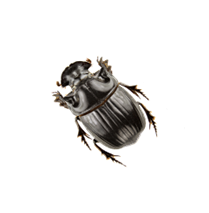About
Dung Beetle Innovations
Launched in 2014, Dung Beetle Innovations owes its existence to the combined efforts of co-founders Dr Shaun Forgie and Andrew Barber.
These two stand on the shoulders of those visionary farmers who were members of the Dung Beetle Release Strategy Group that campaigned since 2009 for the introduction of dung beetles to New Zealand. It’s taken a lifetime of research and dedication to get this far; now we’re ready to fly.
so, where's the beef with animal agriculture?

10 Million
Dairy and beef cattle in New Zealand produce 85 million tonnes of dung per year.

27 Million
Sheep, plus horses and alpaca, produce over 14 million tonnes of dung per year.

100 Milllion
Tonnes of dung is deposited annually on our New Zealand pastures.

Our Mission
Dung Beetle Innovations is dedicated to rebalancing New Zealand’s pastoral farming systems – improving water quality and soil health – through leadership, education and the establishment of dung beetles as a sustainable farm management practice.
Our Vision
“Can you remember a time when the pastures were piled high with dung? When the river was too polluted to swim in?” If, 25 years from now, our kids think we’re making up stories, we’ll have realised our vision: A sustainable, low-cost solution to the environmental and economic challenges we face today.

Over a million good reasons…
“There are 6.5 million dairy cows in New Zealand, each producing on average 27 kilograms of dung a day. By the time you add in another 3.6 million cattle and 27.4 million sheep that is over 100,000,000 tonnes of dung each year.”

Our Timeline
This has been a rigorous process of ticking the right boxes dating back to 2009.
-
November 2009
Public and iwi consultation workshops
November 2009: Public and iwi consultation workshopsPossible risks/costs/benefits of introducing dung beetles brainstormed with representatives from, the Dung Beetle Release Strategy Group (DBRSG), AgResearch, Ngati Whatua Nga Rima o Kaipara, Rangitāne o Manawatū, University of Auckland, and Landcare Research.
-
June 2010
First Appeal with ERMA
June 2010: First Appeal with ERMAThe Dung Beetle Release Strategy Group, assisted by Landcare Research, lodges an appeal with the Environmental Risk Management Authority (ERMA) to release 11 species of dung beetles in New Zealand
-
October 2010
Public submissions close
October 2010: Public submissions closePeriod for public submissions ends. Response is mixed; some submissions are in support, some are opposed while others can’t decide.
-
November 2010
Landcare Research responds
November 2010: Landcare Research respondsLandcare Research responds to scientific issues raised in public submissions.
-
December 2010
ERMA public hearing
December 2010: ERMA public hearingERMA holds a public hearing to debate benefits and potential issues.
-
February 2011
ERMA approval
February 2011: ERMA approvalERMA approves the release without controls of 11 species of dung beetles.
-
March 2011
First two species imported
March 2011: First two species importedThe first two species (Euoniticellus fulvus, Onthophagus taurus) are imported into containment
-
March 2011
Additional research conducted
March 2011: Additional research conductedUniversity of Auckland raises additional concerns after approval has been granted and the appeal period closed.
-
June 2011
Third species imported, mass rearing commences
June 2011: Third species imported, mass rearing commencesA third species Geotrupes spiniger is imported into containment. MAF gives permission to release the first three species from containment. Mass-rearing in enclosed facilities commences in Auckland.
-
August 2011
Fourth species imported
August 2011: Fourth species importedBubas bison imported into containment but insufficient eggs are laid for disease testing.
-
November 2011
EPA upholds approval
November 2011: EPA upholds approvalAfter evaluating additional concerns the EPA (formerly ERMA) affirms their original decision i.e. that any adverse effects would be negligible.
-
December 2011
Pre-release research
December 2011: Pre-release researchre-release research conducted by Landcare Research.
-
February 2012
Two more species imported
February 2012: Two more species importedOnthophagus gazella and O. binodis imported into containment.
-
May 2012
TAG established
May 2012: TAG establishedStakeholders’ Technical Advisory Group (TAG) established to advise the DBRSG on
the best way to progress the project, to maximize potential benefits while taking into account all stakeholders’ needs and the need to protect the environment. -
Sept 2012 – June 2013
Landcare Research trials
Sept 2012 – June 2013: Landcare Research trialsLandcare Research conducts three trials proposed by the TAG to answer any outstanding questions.
-
February 2013 – August 2013
ESR human health risk assessment
February 2013 – August 2013: ESR human health risk assessmentThe Institute of Environmental Science and Research (ESR) conducts an internationally peer reviewed human health risk assessment.
-
September 2013
TAG meets DBRSG with recommendations
September 2013: TAG meets DBRSG with recommendationsThe TAG evaluates the commissioned trials and public health review, with a view to identify the next steps and presenting the meetings findings to the DBRSG. With all questions raised adequately answered, the TAG recommends that beetle releases proceed, and that a monitoring programme be put in place.
-
September 2013
The DBRSG committee meets to discuss implementation of TAG findings
September 2013: The DBRSG committee meets to discuss implementation of TAG findingsThe DBRSG committee meets to discuss the TAG findings. We are now working with our science provider, Landcare Research, to develop a release strategy, monitoring and on-going research programme. These details will be provided to the farming community as quickly as possible.
-
September 2013
First dung beetle release
September 2013: First dung beetle releaseThe first release of 500 dung beetles (Onthophagus taurus and O. binodus) on New Zealand soil takes place on 26 September on an organic dairy farm in Gore.
-
October 2013
First North Island dung beetle release
October 2013: First North Island dung beetle releaseThe first North Island dung beetle release (species) in Wairarapa.
-
February 2014
Dung Beetle Innovations is up and flying
February 2014: Dung Beetle Innovations is up and flyingA total of 74 dung beetle releases have taken place across 7 regions from Northland to
Southland. -
January 2018
Over 200 colonies have been released to date
January 2018: Over 200 colonies have been released to date


Winning
everyone’s approval
When it comes to world-changing ideas, resistance is always to be expected. The dung beetle solution was no exception.
Exhaustive research, presentations, negotiations, and workshops were conducted in order to satisfy the concerns of all stakeholders: government, EPA (formerly ERMA), upholds approval, iwi, farmers, environmentalists, academics and the general public.
In the face of overwhelming evidence in support of dung beetles, in February 2011 the release of dung beetles in New Zealand was finally given the official green light. However, it would take two further years of continual reassessment before the first 500 dung beetles would take flight in their new home – a dairy farm in Gore – on 26 September 2013.

From approval to accolades…
DBI are proud to share that after years of laying the foundations for better animal agriculture in New Zealand, we were 2017 Finalists in the prestigious NZI Sustainable Business Awards in the Transforming Food category. In 2019 we made the finals in these awards for two categories: Restoring Nature and Partnering for Good.







